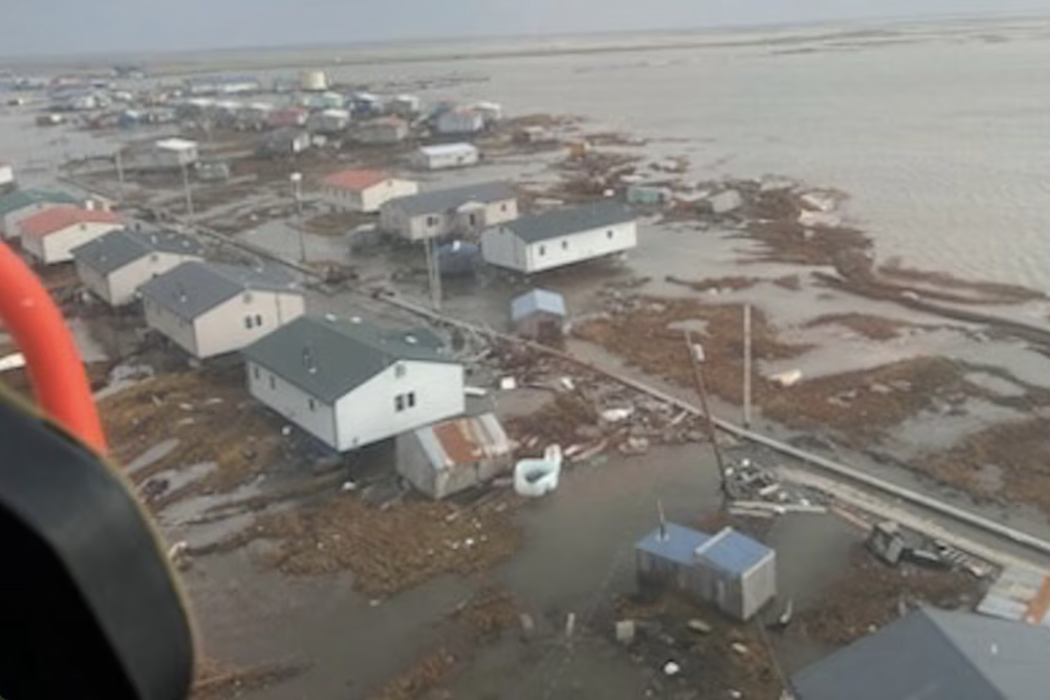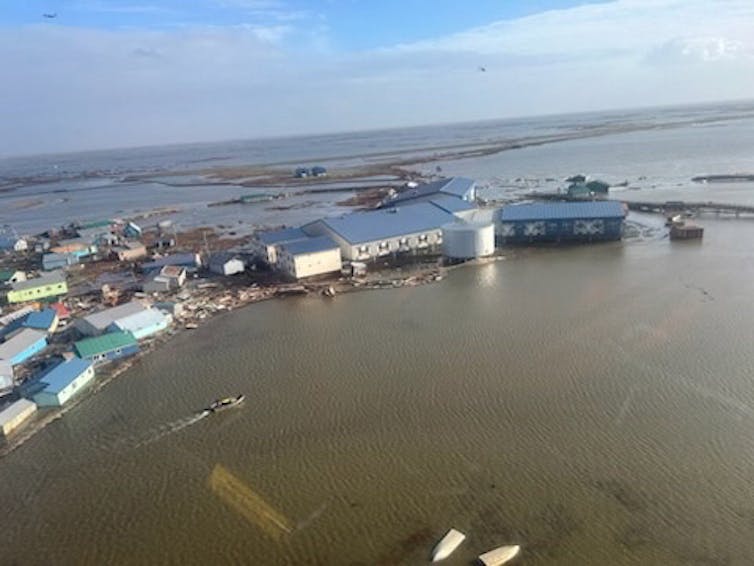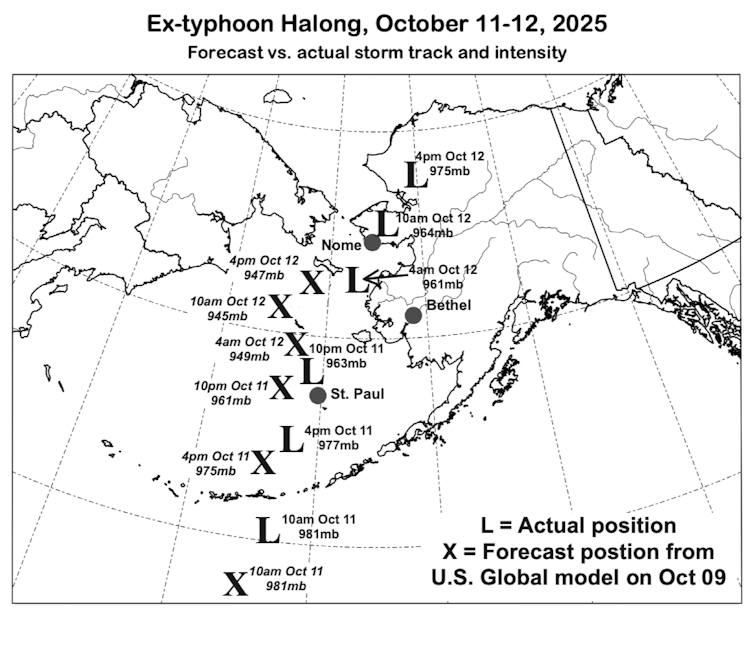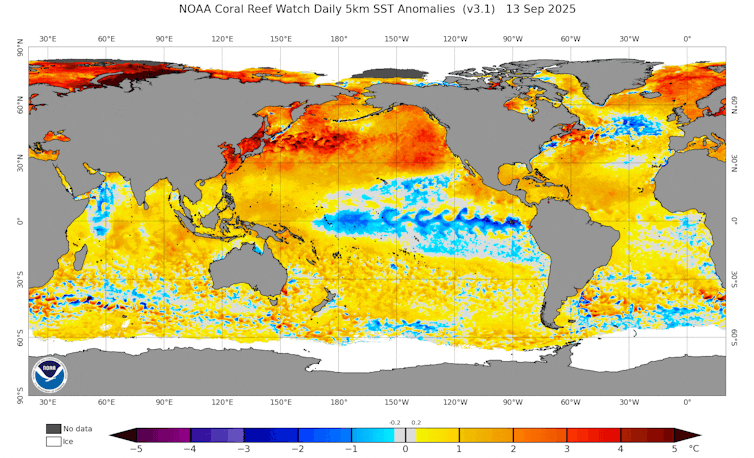Typhoon leaves flooded Alaska villages facing a storm recovery far tougher than most Americans will ever experience
- Remnants of Typhoon Halong swept into Western Alaska’s Yukon-Kuskokwim Delta on October 12, 2025, causing widespread flooding and displacement in villages as far as 60 miles up the river.
- The storm surge and powerful winds knocked homes off their foundations, set some afloat with people inside, and resulted in at least one person’s death, with over 50 people needing to be rescued in Kipnuk and Kwigillingok.
- The unusual storm was likely fueled by the Pacific’s near-record warm surface temperatures this fall, making recovery even more difficult for these hard-hit communities, which are already vulnerable due to their remote location and lack of infrastructure.
- Disaster response efforts will be complicated by the fact that many of these villages have no roads to cities, limited access to supplies, and a shortage of housing, with displaced people facing difficult decisions about whether to leave for the winter or try to rebuild next summer.
- The storm’s unusual track and intensity were likely influenced by the loss of weather balloon data in the Bering Sea, which may have affected forecast performance, and climate change is also playing a role, as warmer sea-surface temperatures fueled the storm and brought warm air northward with it.

Remnants of a powerful typhoon swept into Western Alaska’s Yukon-Kuskokwim Delta on Oct. 12, 2025, producing a storm surge that flooded villages as far as 60 miles up the river. The water pushed homes off their foundations and set some afloat with people inside, officials said. More than 50 people had to be rescued in Kipnuk and Kwigillingok, hundreds were displaced in the region, and at least one person died.
Typhoon Halong was an unusual storm, likely fueled by the Pacific’s near-record warm surface temperatures this fall. Its timing means recovery will be even more difficult than usual for these hard-hit communities, as Alaska meteorologist Rick Thoman of the University Alaska Fairbanks explains.
Disasters in remote Alaska are not like disasters anywhere in the lower 48 states, he explains. While East Coast homeowners recovering from a nor’easter that flooded parts of New Jersey and other states the same weekend can run to Home Depot for supplies or drive to a hotel if their home floods, none of that exists in remote Native villages.

U.S. Coast Guard via AP
What made this storm unusual?
Halong was an ex-typhoon, similar to Merbok in 2022, by the time it reached the delta. A week earlier, it had been a powerful typhoon east of Japan. The jet stream picked it up and carried it to the northeast, which is pretty common, and weather models did a pretty good job in forecasting its track into the Bering Sea.
But as the storm approached Alaska, everything went sideways.
The weather model forecasts changed, reflecting a faster-moving storm, and Halong shifted to a very unusual track, moving between Saint Lawrence Island and the Yukon-Kuskokwim Delta coast.

Rick Thoman
Unlike Merbok, which was very well forecast by the global models, this one’s final track and intensity weren’t clear until the storm was within 36 hours of crossing into Alaska waters. That’s too late for evacuations in many places.
Did the loss of weather balloon data canceled in 2025 affect the forecast?
That’s a question for future research, but here’s what we know for sure: There have not been any upper-air weather balloon observations at Saint Paul Island in the Bering Sea since late August or at Kotzebue since February. Bethel and Cold Bay are limited to one per day instead of two. At Nome, there were no weather balloons for two full days as the storm was moving toward the Bering Sea.
Did any of this cause the forecast to be off? We don’t know because we don’t have the data, but it seems likely that that had some effect on the model performance.
Why is the delta region so vulnerable in a storm like Halong?
The land in this part of western Alaska is very flat, so major storms can drive the ocean into the delta, and the water spreads out.
Most of the land there is very close to sea level, in some places less than 10 feet above the high tide line. Permafrost is also thawing, land is subsiding, and sea-level rise is adding to the risk. For many people, there is literally nowhere to go. Even Bethel, the region’s largest town, about 60 miles up the Kuskokwim River, saw flooding from Halong.
These are very remote communities with no roads to cities. The only way to access them is by boat or plane. Right now, they have a lot of people with nowhere to live, and winter is closing in.
These villages are also small. They don’t have extra housing or the resources to rapidly recover. The region was already recovering from major flooding in summer 2024. Kipnuk’s tribe was able to get federal disaster aid, but that aid was approved only in early January 2025.
What are these communities facing in terms of recovery?
People are going to have really difficult decisions to make. Do they leave the community for the winter and hope to rebuild next summer?
There likely isn’t much available housing in the region, with the flooding so widespread on top of a housing shortage. Do displaced people go to Anchorage? Cities are expensive.
There is no easy answer.
It’s logistically complicated to rebuild in places like Kipnuk. You can’t just get on the phone and call up your local building contractor.
Almost all of the supplies have to come in by barge – plywood to nails to windows – and that isn’t going to happen in winter. You can’t truck it in – there are no roads. Planes can only fly in small amounts – the runways are short and not built for cargo planes.
The National Guard might be able to help fly in supplies. But then you still need to have people who can do the construction and other repair work.
Everything is 100 times more complicated when it comes to building in remote communities. Even if national or state help is approved, it would be next summer before most homes could be rebuilt.
Is climate change playing a role in storms like these?
That will be another question for future research, but sea-surface temperature in most of the North Pacific that Typhoon Halong passed over before reaching the Aleutian Islands has been much warmer than normal. Warm water fuels storms.

NOAA Coral Reef Watch
Halong also brought lots of very warm air northward with it. East of the track on Oct. 11, Unalaska reached 68 degrees Fahrenheit (20 degrees Celsius), an all-time high there for October.
![]()
Rick Thoman retired from National Weather Service Alaska Region in 2018.
